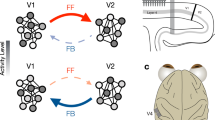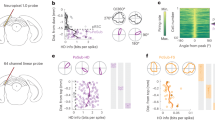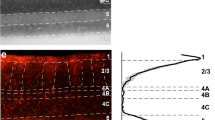Abstract
The cortex is sensitive to weak stimuli, but responds to stronger inputs without saturating. The mechanisms that enable this wide range of operation are not fully understood. We found that the amplitude of excitatory synaptic currents necessary to fire rodent pyramidal cells, the threshold excitatory current, increased with stimulus strength. Consequently, the relative contribution of individual afferents in firing a neuron was inversely proportional to the total number of active afferents. Feedforward inhibition, acting homogeneously across pyramidal cells, ensured that threshold excitatory currents increased with stimulus strength. In contrast, heterogeneities in the distribution of excitatory currents in the neuronal population determined the specific set of pyramidal cells recruited. Together, these mechanisms expand the range of afferent input strengths that neuronal populations can represent.
This is a preview of subscription content, access via your institution
Access options
Subscribe to this journal
Receive 12 print issues and online access
$209.00 per year
only $17.42 per issue
Buy this article
- Purchase on Springer Link
- Instant access to full article PDF
Prices may be subject to local taxes which are calculated during checkout







Similar content being viewed by others
References
Lefort, S., Tomm, C., Floyd Sarria, J.C. & Petersen, C.C. The excitatory neuronal network of the C2 barrel column in mouse primary somatosensory cortex. Neuron 61, 301–316 (2009).
Otmakhov, N., Shirke, A.M. & Malinow, R. Measuring the impact of probabilistic transmission on neuronal output. Neuron 10, 1101–1111 (1993).
Marr, D. A theory of cerebellar cortex. J. Physiol. (Lond.) 202, 437–470 (1969).
Vogels, T.P. & Abbott, L.F. Signal propagation and logic gating in networks of integrate-and-fire neurons. J. Neurosci. 25, 10786–10795 (2005).
Shadlen, M.N. & Newsome, W.T. The variable discharge of cortical neurons: implications for connectivity, computation and information coding. J. Neurosci. 18, 3870–3896 (1998).
Diesmann, M., Gewaltig, M.O. & Aertsen, A. Stable propagation of synchronous spiking in cortical neural networks. Nature 402, 529–533 (1999).
Arabzadeh, E., Zorzin, E. & Diamond, M.E. Neuronal encoding of texture in the whisker sensory pathway. PLoS Biol. 3, e17 (2005).
Wilson, M.A. & McNaughton, B.L. Dynamics of the hippocampal ensemble code for space. Science 261, 1055–1058 (1993).
Csicsvari, J., Hirase, H., Mamiya, A. & Buzsaki, G. Ensemble patterns of hippocampal CA3–CA1 neurons during sharp wave–associated population events. Neuron 28, 585–594 (2000).
Shu, Y., Hasenstaub, A., Badoual, M., Bal, T. & McCormick, D.A. Barrages of synaptic activity control the gain and sensitivity of cortical neurons. J. Neurosci. 23, 10388–10401 (2003).
Mitchell, S.J. & Silver, R.A. Shunting inhibition modulates neuronal gain during synaptic excitation. Neuron 38, 433–445 (2003).
Chance, F.S., Abbott, L.F. & Reyes, A.D. Gain modulation from background synaptic input. Neuron 35, 773–782 (2002).
Carvalho, T.P. & Buonomano, D.V. Differential effects of excitatory and inhibitory plasticity on synaptically driven neuronal input-output functions. Neuron 61, 774–785 (2009).
Tropp Sneider, J., Chrobak, J.J., Quirk, M.C., Oler, J.A. & Markus, E.J. Differential behavioral state-dependence in the burst properties of CA3 and CA1 neurons. Neuroscience 141, 1665–1677 (2006).
Pouille, F. & Scanziani, M. Enforcement of temporal fidelity in pyramidal cells by somatic feedforward inhibition. Science 293, 1159–1163 (2001).
Buzsáki, G. Feed-forward inhibition in the hippocampal formation. Prog. Neurobiol. 22, 131–153 (1984).
Alger, B.E. & Nicoll, R.A. Feed-forward dendritic inhibition in rat hippocampal pyramidal cells studied in vitro. J. Physiol. (Lond.) 328, 105–123 (1982).
Nicoll, R.A., Alger, B.E. & Jahr, C.E. Enkephalin blocks inhibitory pathways in the vertebrate CNS. Nature 287, 22–25 (1980).
Somogyi, P. & Klausberger, T. Defined types of cortical interneurone structure space and spike timing in the hippocampus. J. Physiol. (Lond.) 562, 9–26 (2005).
Freund, T.F. & Buzsáki, G. Interneurons of the hippocampus. Hippocampus 6, 347–470 (1996).
Glickfeld, L.L. & Scanziani, M. Distinct timing in the activity of cannabinoid-sensitive and cannabinoid-insensitive basket cells. Nat. Neurosci. 9, 807–815 (2006).
Maccaferri, G. & Dingledine, R. Control of feedforward dendritic inhibition by NMDA receptor–dependent spike timing in hippocampal interneurons. J. Neurosci. 22, 5462–5472 (2002).
Geiger, J.R., Lubke, J., Roth, A., Frotscher, M. & Jonas, P. Submillisecond AMPA receptor–mediated signaling at a principal neuron-interneuron synapse. Neuron 18, 1009–1023 (1997).
Cruikshank, S.J., Lewis, T.J. & Connors, B.W. Synaptic basis for intense thalamocortical activation of feedforward inhibitory cells in neocortex. Nat. Neurosci. 10, 462–468 (2007).
Sayer, R.J., Friedlander, M.J. & Redman, S.J. The time course and amplitude of EPSPs evoked at synapses between pairs of CA3/CA1 neurons in the hippocampal slice. J. Neurosci. 10, 826–836 (1990).
Gabernet, L., Jadhav, S.P., Feldman, D.E., Carandini, M. & Scanziani, M. Somatosensory integration controlled by dynamic thalamocortical feed-forward inhibition. Neuron 48, 315–327 (2005).
Helmstaedter, M., Staiger, J.F., Sakmann, B. & Feldmeyer, D. Efficient recruitment of layer 2/3 interneurons by layer 4 input in single columns of rat somatosensory cortex. J. Neurosci. 28, 8273–8284 (2008).
Daw, M.I., Ashby, M.C. & Isaac, J.T. Coordinated developmental recruitment of latent fast spiking interneurons in layer IV barrel cortex. Nat. Neurosci. 10, 453–461 (2007).
Mittmann, W., Koch, U. & Hausser, M. Feed-forward inhibition shapes the spike output of cerebellar Purkinje cells. J. Physiol. (Lond.) 563, 369–378 (2005).
Saito, T. & Nakatsuji, N. Efficient gene transfer into the embryonic mouse brain using in vivo electroporation. Dev. Biol. 240, 237–246 (2001).
Petreanu, L., Huber, D., Sobczyk, A. & Svoboda, K. Channelrhodopsin-2–assisted circuit mapping of long-range callosal projections. Nat. Neurosci. 10, 663–668 (2007).
Bruno, R.M. & Sakmann, B. Cortex is driven by weak, but synchronously active, thalamocortical synapses. Science 312, 1622–1627 (2006).
Porter, J.T., Johnson, C.K. & Agmon, A. Diverse types of interneurons generate thalamus-evoked feedforward inhibition in the mouse barrel cortex. J. Neurosci. 21, 2699–2710 (2001).
Poo, C. & Isaacson, J.S. Odor representations in olfactory cortex: “sparse” coding, global inhibition and oscillations. Neuron 62, 850–861 (2009).
Holmgren, C., Harkany, T., Svennenfors, B. & Zilberter, Y. Pyramidal cell communication within local networks in layer 2/3 of rat neocortex. J. Physiol. (Lond.) 551, 139–153 (2003).
Beierlein, M., Gibson, J.R. & Connors, B.W. Two dynamically distinct inhibitory networks in layer 4 of the neocortex. J. Neurophysiol. 90, 2987–3000 (2003).
Thomson, A.M., West, D.C., Wang, Y. & Bannister, A.P. Synaptic connections and small circuits involving excitatory and inhibitory neurons in layers 2–5 of adult rat and cat neocortex: triple intracellular recordings and biocytin labeling in vitro. Cereb. Cortex 12, 936–953 (2002).
Buhl, E.H., Halasy, K. & Somogyi, P. Diverse sources of hippocampal unitary inhibitory postsynaptic potentials and the number of synaptic release sites. Nature 368, 823–828 (1994).
Blitz, D.M. & Regehr, W.G. Timing and specificity of feed-forward inhibition within the LGN. Neuron 45, 917–928 (2005).
Agmon, A. & Connors, B.W. Thalamocortical responses of mouse somatosensory (barrel) cortex in vitro. Neuroscience 41, 365–379 (1991).
Vaillend, C., Mason, S.E., Cuttle, M.F. & Alger, B.E. Mechanisms of neuronal hyperexcitability caused by partial inhibition of Na+-K+-ATPases in the rat CA1 hippocampal region. J. Neurophysiol. 88, 2963–2978 (2002).
Nakamura, M., Sekino, Y. & Manabe, T. GABAergic interneurons facilitate mossy fiber excitability in the developing hippocampus. J. Neurosci. 27, 1365–1373 (2007).
Winegar, B.D. & MacIver, M.B. Isoflurane depresses hippocampal CA1 glutamate nerve terminals without inhibiting fiber volleys. BMC Neurosci. 7, 5 (2006).
Steiger, J.H. Tests for comparing elements of a correlation matrix. Psychol. Bull. 87, 245–251 (1980).
Acknowledgements
We thank P. Abelkop for anatomical reconstructions of biocytin filled neurons, F. Fröhlich for developing the initial versions of model, M. Carandini and J. Isaacson for comments and suggestions during the entire course of the project, C. Poo and F. Bertaso for inputs on the manuscript, and all of the members of the Scanziani laboratory for their input on the project and the manuscript. M.S. thanks C. Staub for the original discussions leading to the project. This work was funded in part by the US National Institutes of Health (MH71401 to M.S. and NS061521 to B.V.A.). H.A. is a fellow of the Helen Hay Whithney Foundation. M.S. is an investigator of the Howard Hughes Medical Institute.
Author information
Authors and Affiliations
Contributions
F.P. and A.M.-B. conducted the experiments in the hippocampus; H.A. conducted the experiments in the somatosensory cortex; B.V.A. made the model; and M.S. supervised the project and wrote the manuscript.
Corresponding author
Supplementary information
Supplementary Text and Figures
Supplementary Figures 1–10 (PDF 543 kb)
Rights and permissions
About this article
Cite this article
Pouille, F., Marin-Burgin, A., Adesnik, H. et al. Input normalization by global feedforward inhibition expands cortical dynamic range. Nat Neurosci 12, 1577–1585 (2009). https://doi.org/10.1038/nn.2441
Received:
Accepted:
Published:
Issue Date:
DOI: https://doi.org/10.1038/nn.2441
This article is cited by
-
Subfield-specific interneuron circuits govern the hippocampal response to novelty in male mice
Nature Communications (2024)
-
Shank3 deletion in PV neurons is associated with abnormal behaviors and neuronal functions that are rescued by increasing GABAergic signaling
Molecular Autism (2023)
-
Pathway-specific contribution of parvalbumin interneuron NMDARs to synaptic currents and thalamocortical feedforward inhibition
Molecular Psychiatry (2022)
-
Inhibition for gain modulation in the motor system
Experimental Brain Research (2022)
-
The role of astrocytes in place cell formation: A computational modeling study
Journal of Computational Neuroscience (2022)



